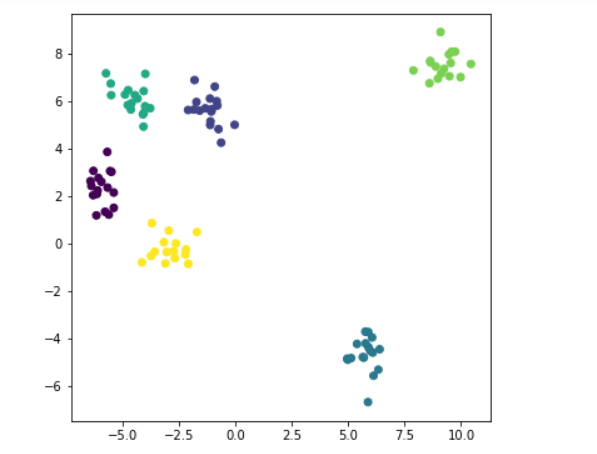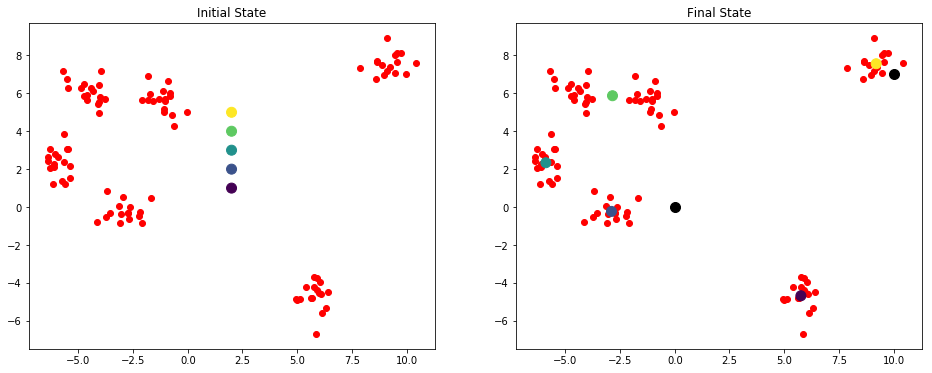无监督学习
相对监督学习(输入进x,有对应的y),没有标注
聚类
- k均值
- 基于密度的聚类
- 最大期望聚类
降维
- 潜语义分析(LSA)
- 主成分分析(PCA)
- 奇异值分解(SVD)

k 均值(k-means)是聚类算法中最为简单、高效的,属于无监督学习算法
核心思想:由用户指定k个初始质心(initial centroids),以作为聚类的类别(cluster),重复迭代直至算法收敛
基本算法流程:
- 选取k个初始质心(作为初始cluster);
- repeat:
对每个样本点,计算得到距其最近的质心,将其类别标为该质心所对应的cluster; 重新计算k个cluser对应的质心; until 质心不再发生变化或迭代达到上限
kmeans代码实现
import numpy as np import matplotlib.pyplot as plt # 从sklearn中直接生成聚类数据 from sklearn.datasets.samples_generator import make_blobs
加载数据
x, y = make_blobs( n_samples=100, centers=6, random_state=1234, cluster_std=0.6 ) #100个样本,centers生成的样本中心(类别)数; random_state --seed used by the random number generator; #cluster_std为每个类别设置不同的方差 #x.shape #(100, 2) plt.figure(figsize=(6,6)) plt.scatter(x[:,0], x[:,1], c=y) #c=y 6类,变得有颜色 plt.show()

算法实现
# 引入scipy中的距离函数,默认计算欧式距离 from scipy.spatial.distance import cdist class K_Means(object): # 初始化,参数 n_clusters(K)、迭代次数max_iter、初始质心 centroids def __init__(self, n_clusters=5, max_iter=300, centroids=[]): self.n_clusters = n_clusters self.max_iter = max_iter self.centroids = np.array( centroids, dtype=np.float ) # 训练模型方法,k-means聚类过程,传入原始数据 def fit(self, data): # 假如没有指定初始质心,就随机选取data中的点作为初始质心 if( self.centroids.shape == (0,) ): # 从data中随机生成0到data行数的6个整数,作为索引值 self.centroids = data[ np.random.randint( 0, data.shape[0], self.n_clusters ) ,: ] # 开始迭代 for i in range(self.max_iter): # 1. 计算距离矩阵,得到的是一个100*6的矩阵 distances = cdist(data, self.centroids) # 2. 对距离按有近到远排序,选取最近的质心点的类别,作为当前点的分类 c_ind = np.argmin( distances, axis=1 ) #axis=1保留最近一列 # 3. 对每一类数据进行均值计算,更新质心点坐标 for i in range(self.n_clusters ): # 排除掉没有出现在c_ind里的类别 if i in c_ind: # 选出所有类别是i的点,取data里面坐标的均值,更新第i个质心 #data[c_ind==i]布尔索引,拿到为true的值 self.centroids[i] = np.mean( data[c_ind==i], axis=0 ) # 实现预测方法 def predict(self, samples): # 跟上面一样,先计算距离矩阵,然后选取距离最近的那个质心的类别 distances = cdist(samples, self.centroids) c_ind = np.argmin( distances, axis=1 ) return c_ind ##测试下,二维数组5 * 4(4个质心点),行数代表有几个点,一行数是跟每一个质心的距离 dist = np.array([[121,221,32,43], [121,1,12,23], [65,21,2,43], [1,221,32,43], [21,11,22,3],]) c_ind = np.argmin( dist, axis=1 ) print(c_ind) #每一个元素跟哪一类最近 [2 1 2 0 3] x_new=x[0:5] print(x_new)# print(c_ind==2) #[ True False True False False] print(x_new[c_ind==2]) np.mean(x_new[c_ind==2], axis=0) #每一个坐标每一列对应的平均值
----->>
[2 1 2 0 3] [[-0.02708305 5.0215929 ] [-5.49252256 6.27366991] [-5.37691608 1.51403209] [-5.37872006 2.16059225] [ 9.58333171 8.10916554]] [ True False True False False] [[-0.02708305 5.0215929 ] [-5.37691608 1.51403209]] Out[14]: array([-2.70199956, 3.26781249])
测试
# 定义一个绘制子图函数 def plotKMeans(x, y, centroids, subplot, title): # 分配子图,121表示1行2列的子图中的第一个 plt.subplot(subplot) plt.scatter(x[:,0], x[:,1], c='r') # 画出质心点 plt.scatter(centroids[:,0], centroids[:,1], c=np.array(range(5)), s=100) plt.title(title) #centroids指定初始点 kmeans = K_Means(max_iter=300, centroids=np.array([[2,1],[2,2],[2,3],[2,4],[2,5]])) plt.figure(figsize=(16, 6)) #初始状态的图 plotKMeans( x, y, kmeans.centroids, 121, 'Initial State' ) # 开始聚类 kmeans.fit(x) plotKMeans( x, y, kmeans.centroids, 122, 'Final State' ) # 预测新数据点的类别 x_new = np.array([[0,0],[10,7]]) y_pred = kmeans.predict(x_new) print(kmeans.centroids) print(y_pred) plt.scatter(x_new[:,0], x_new[:,1], s=100, c='black') ---->> [[ 5.76444812 -4.67941789] [-2.89174024 -0.22808556] [-5.89115978 2.33887408] [-2.8455246 5.87376915] [ 9.20551979 7.56124841]] [1 4]
